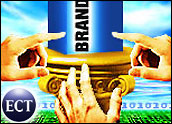
It is no secret that “retail therapy” — whether in the form of shopping at a designer boutique, visiting a favorite online retailer, or even purchasing a preferred brand of shampoo from the grocery store — can evoke feelings of happiness and well-being. A fascinating new study by marketing guru Martin Lindstrom reveals that the brain actually receives an emotional boost from such experiences, and that the boost intensifies when consumers interface with so-called “strong” brands.
In his new book, Buy-ology — Truth and Lies About Why We Buy, Lindstrom details the intriguing results of a three-year, US$7 million study in which his team submitted 2,000 people to fMRI scans to determine how consumers’ brains respond to stimulus ranging from logos to religious images. The study found that when people viewed strong brands — such as those associated with iPod, Harley Davidson, Ferrari, and others — their brains registered the same patterns of emotional engagement as when viewing religious images. However, when the subjects viewed weaker brands, completely different areas of their brains were activated, suggesting that weaker weak brands do not evoke the same emotional response as strong brands.
Lindstrom explained that emotions are the way in which our brains encode things of value, stating that brands that engage consumers emotionally will “win every single time.” So, how can companies create such strong brands in times of limited economic resources?
What Makes a Brand ‘Strong’?
From a marketing perspective, so-called “strong” brands can be defined as those that enjoy widespread consumer recognition, trust and loyalty. From a legal perspective, strong brands are those that are available for protection through trademark registration, and are enforceable against third parties who may wish to benefit from the goodwill inured in such brands.
By taking a few simple steps at the beginning of the branding process, companies can ensure that new brands have the potential to become strong brands.
Select Inherently Strong, Protectable Brand Names
When selecting a new brand name, companies need to consider the types of trademarks that are inherently considered protectable and registrable. Trademarks fall along a spectrum of distinctiveness that determines the amount of protection they will receive:
Coined Marks consist of words or symbols invented solely for the purpose of serving as a trademark. Coined marks are extremely strong marks that are immediately protectable and registrable and are entitled to the broadest scope of protection available.
- Arbitrary Marks consist of words or terms in common linguistic use that do not describe or suggest any characteristics of the products or services with which they are used. Arbitrary marks are immediately protectable and registrable and are entitled to a broad scope of protection.
- Suggestive Marks require the consumer to exercise some thought or imagination to determine the nature of the products or services with which the mark is used. They do not immediately describe any feature, ingredient, function, or other characteristic of the product or service, but rather only suggest or allude to one or more of its characteristics. Although not as strong as coined and arbitrary marks, suggestive marks are also immediately protectable and registrable.
- Descriptive Marks immediately describe a feature, ingredient, function, intended result, or other characteristic of the products or services with which the mark is used. The law presumes that such descriptive terms must be available for all to use to describe their products and services fairly and accurately to the public. Thus, descriptive marks are not immediately protectable. They can become protectable only if the trademark owner can demonstrate that the mark has acquired distinctiveness in the marketplace.
- Generic Terms — the common names of products (e.g., “computer,” “bread,” “car,” “soap”) — are incapable of functioning as trademarks under any circumstances.
Companies should select new brand names that are coined, arbitrary or suggestive. While it can be tempting to select descriptive trademarks, as they immediately describe the nature of the product or service, such brands can require much more effort and expense to differentiate from competitors, and are thus less likely to become strong brands.
Plan Ahead
One of the easiest ways for companies to ensure that their brands have the potential to become “strong” is to select new trademarks early in the product development cycle. The earlier a brand name is selected, the more time the marketing department has to conceptualize promotional strategies surrounding the name, and the more time the legal department has to perform critical trademark clearance procedures and implement filing strategies.
Selecting a brand name too late in the cycle often pits legal and marketing departments against one another, as the marketing department’s mandate to bring a product to market overrides the legal department’s responsibility to clear a trademark for use and registration.
Select Alternate Names
Often, companies select brand names for emotional reasons, ignoring the advice of trademark professionals regarding a favored brand name’s registrability or protectability.
By planning ahead and conceiving a number of alternate marks, companies can ensure they have a backup plan should the original name prove unprotectable or unavailable.
Strong Brand Marketing Strategies
One way to differentiate your company’s offerings during a recession is to associate your product or service with so-called nontraditional trademarks such as trade dress (the shape of the product, the look and feel of a Web site, or even the decor of a store), smell and color.
Specifically, Lindstrom revealed that consumers react strongly to nontraditional trademarks, and that use of these types of marks can create even greater brand strength and product loyalty than traditional logos and brand names. Such nontraditional trademarks can also be available for trademark registration, which improves the owner’s ability to preclude others from using confusingly similar designations.
Invest in Targeted Protection
Even though budgets may be tight, now is not the time to skimp on trademark registration. If you plan to launch a product or service internationally, be sure to file trademark applications in the countries in which to you plan to do business. Unlike in the United States where rights stem from use, most foreign countries grant trademark protection based on a “first to file” system. Failing to file for trademark protection in such countries can have costly results: having to change a trademark late in the product lifecycle; having to pay infringers for the right to register your mark abroad; or weakening of the mark due to use and registration by infringers.
For marketers in recessionary times, Lindstrom’s study suggests interesting opportunities. Marketing during a recession has the potential to make a large impact on customers and potential customers, providing an opportunity for your company’s message to stand out from a less-cluttered field of competitors. By selecting inherently strong brand names, devoting time to the trademark selection and clearance process, and considering use of nontraditional trademarks, companies can lay the groundwork for creating strong, memorable brands.
Monica Riva Talley is a partner in the intellectual property law firm of Finnegan, Henderson, Farabow, Garrett, and Dunner in Washington, D.C. She counsels corporate clients on trademark selection, protection, portfolio management and enforcement. In her former life, Talley worked as an advertising copywriter for an advertising agency and as the director of marketing for a technology firm.



































Social Media
See all Social Media